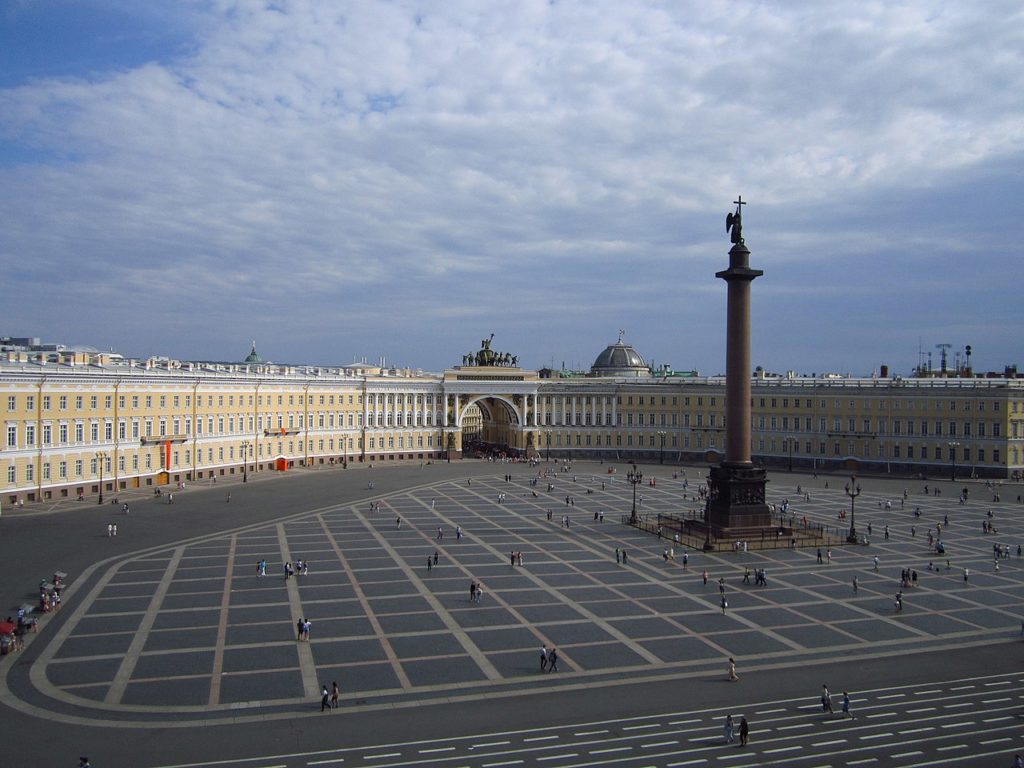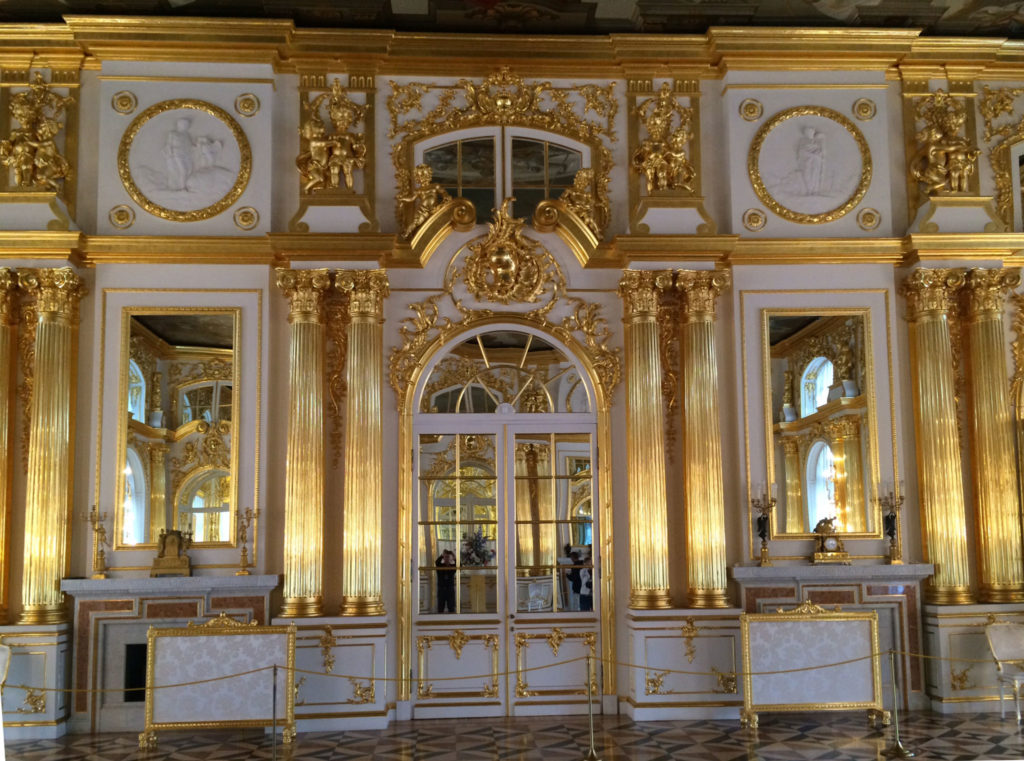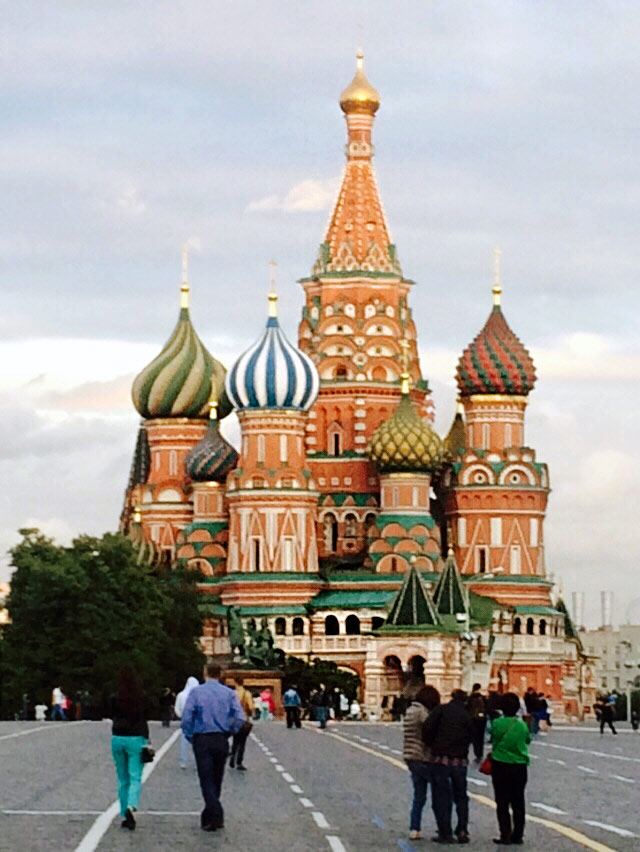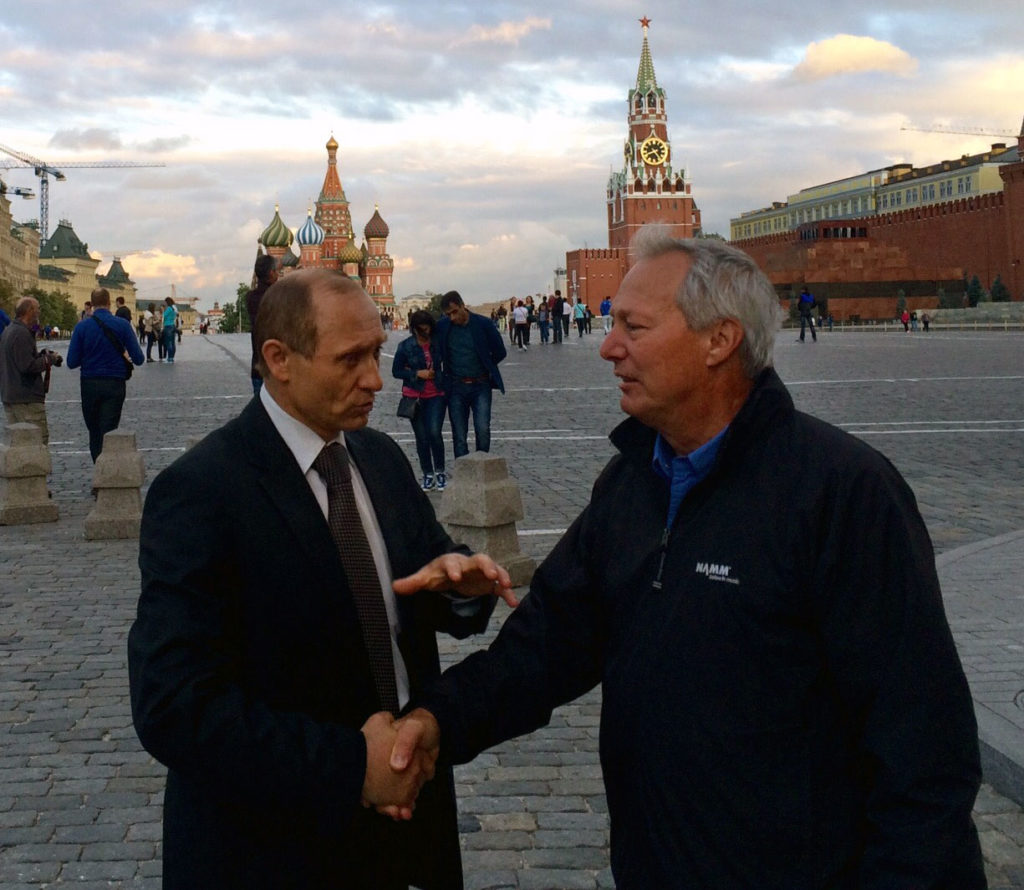In the spring of 2015, I recruited two old friends and my father-in-law to explore the Baltics and Russia. We signed on to a trip organized by Overseas Adventure Travel—my favorite for their small groups and local experiences.
St. Petersburg is every bit the spectacle it was built to be. Its concentric circles of canals, opulent palaces, outsized government offices, spacious parks, repeating terraces, and elegantly proportioned architecture were the life work and obsession of Peter the Great who intended the city to showcase Russia’s imperial might and serve as its “Window to the West.”
The city’s construction required the conscription of hundreds of thousands of Russian peasants. As they died from the mosquitos and cold, more were brought in from the countryside.
St. Petersburg does indeed rank among the world’s most beautiful cities. It’s easy to envision the opulent lifestyle of the tsars and tsarinas, patronizing literature, introducing ballet, commissioning art, and reaching for extremes in architecture. It was Russia’s proud and impressive capital for more than 200 years.
Nevertheless, I couldn’t help seeing its grandiosity, its fixation on size, and its cost in human lives as a repudiation of Russian lifestyle and a longing for acceptance among the more refined civilizations to its west.
In 1918, the Bolshevik revolutionaries spurned St. Petersburg’s imperial style, renamed it Leningrad, and moved the capital back to Moscow.
Twenty three years later, German troops surrounded Leningrad. Hitler’s orders included: “…no interest in the continued existence of this large urban center. Following the city’s encirclement, requests for surrender negotiations shall be denied, since the problem of relocating and feeding the population cannot and should not be solved by us.” The siege lasted 872 days. Fortunately for the inhabitants, Leningrad never fell.
Four hundred miles to the southeast lies Russia’s present capital, its metro area home to over 20 million people.
The heart of Moscow is Red Square, the boundaries of which are defined by some of Russia’s most iconic landmarks: the walled Kremlin, the colorful domes of St. Basil’s Cathedral, Lenin’s mausoleum, the Moscow Museum of History, and the GUM shopping mall.
St. Basil’s is perhaps the icon that most identifies Red Square, probably because it is so jarringly incongruous with everything else there. Indeed, it belongs to another era—built by Ivan the Terrible in 1552 to commemorate his defeat of the Tartars in Kazan. Although it’s called a cathedral, it’s more a labyrinth of narrow corridors connecting nine small chapels. The largest chapel is 151 ft tall inside but has a floor area of only 690 sq ft.
Legend has it that Ivan put out the eyes of the architect so he wouldn’t repeat the design. We wondered if that signified approval or disapproval; nevertheless, it seemed a clear message not to work for Ivan.
The Kremlin is a red-brick-walled park containing five historic palaces, four beautiful cathedrals, and the Grand Kremlin Palace that is now the residence of the Russian President. Much of it is open for public tours but with high security around the active government offices.
Across Red Square is the GUM, Russia’s historic department store. Before the Russian Revolution of 1917, the GUM contained 1,200 independent stores. The Bolsheviks tried operating it in the 1920s as a retail model to serve all classes, but the concept didn’t sell. In the 70s and 80s, it was one of the few Soviet stores that didn’t have shortages of goods—but it had lines, sometimes all the way across Red Square. Today it’s a privately-owned mall with glass skylights, 19h century train station architecture, and over 100 upscale stores.
We took a ride on the Metro, not to go somewhere, but to see its lavish stations, adorned with chandeliers, marble floors, vaulted mosaics, and art. Built in the 1930s, each station is a different work of art, and kept scrupulously clean despite its 9 million riders per day.
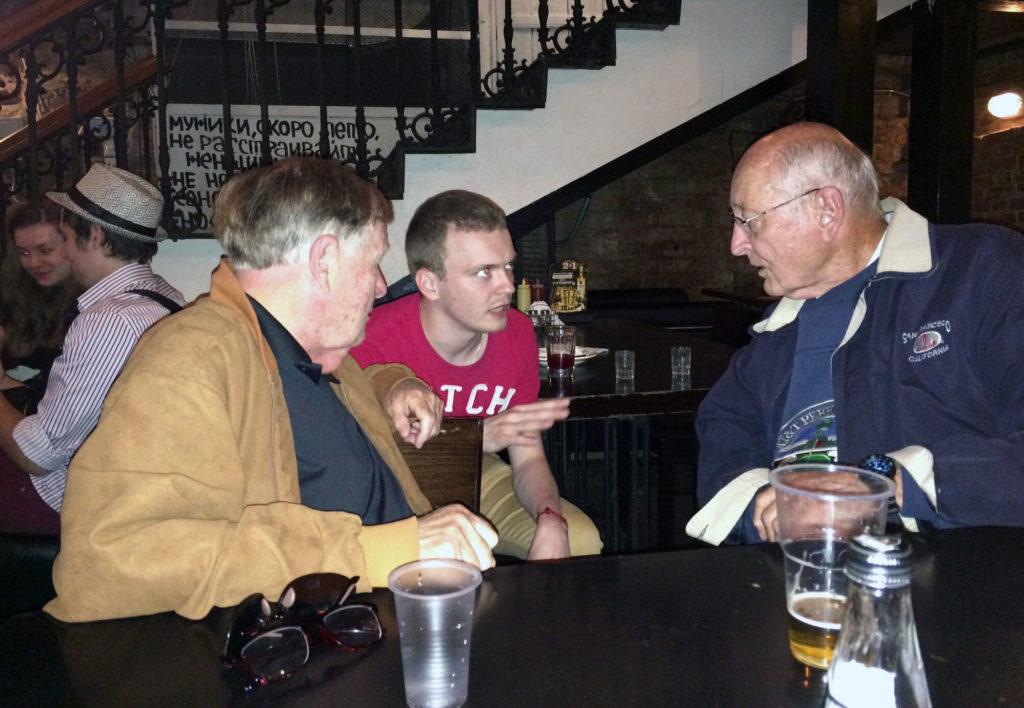
An estimated 11% of Russians speak English and it’s a popular class at universities. To those students, we were an opportunity to practice, and we welcomed the interchange. When their English was good, they were generally open and easy to talk to. We not only sensed no animosity toward westerners, they seemed to crave the interaction.
Most were a strange combination of patriotic and frustrated. They recited impressive facts and statistics about Russia, but often followed them with complaints of low wages, bureaucratic bungles and bottlenecks, dysfunctional systems, censorship, inferior products, corruption, people not working, etc.
One of our arranged speakers described the difficulties she had lived through—four unrelated families living in a communal apartment with one bathroom and one kitchen, scarcity of food, earnings too low to buy even essentials, unresponsive and corrupt government officials, etc.
Russians have been able to travel since the demise of the Soviet Union, but few we met had been far. Many expressed interest; costs were the major challenge, but visas were occasionally difficult. None had been to the US but many said they’d like to. One said he and his fiancé hoped to marry in the US but it proved too expensive.
Their opinions of the US seemed swayed by Russian press and propaganda, but they weren’t entirely fictional; most included the insecurities of capitalism, guns and violence, racism, and expensive healthcare.
Their news of international events had a clear Russian bias and incidents inconvenient to Russia’s reputation were simply unreported.
One student was shocked to hear that many Americans feared Russia’s intentions in world affairs. That was inconceivable to him since he “knew” Russia was virtuous and peaceful. He was also surprised to hear the Baltics didn’t want to be part of a union with Russia again; he couldn’t imagine why not.
Reflections: Histories Explain Politics
In talking to people in Russia, we were sometimes surprised by the political views they expressed—perspectives we couldn’t reconcile with our own. While it’s tempting to simply dismiss points of view we don’t understand as strange or simply wrong, they’re usually a signal that we need to dig deeper. There’s almost always a valid and logical explanation—and it usually originates in their histories.
Russia (and the Soviet Union with Russia as its largest state) had a traumatic and chaotic twentieth century.
In 1917, the peasants and commoners revolted against the Romanov tsars who had exploited them for centuries, and Tsar Nicholas II and his family were eventually executed.
A six-year bloody civil war followed, devastating the economy, and precipitating the 1921 famine that killed an estimated five million. By 1922, at least 7 million homeless children roamed Russian streets.
The revolutionary government that emerged embraced Marxist communism, idealistic and untested, as the antithesis of the extravagant emperors.
Farms, factories, and industry were expropriated, and previous owners and resistors were exiled or executed as “enemies of the people.”
When the productivity of the new agricultural collectives dwindled, millions more starved to death in the Great Famine of 1932-1933.
By the early 1930s, Joseph Stalin had totalitarian control of the government and killed, deported, or sent to labor camps political competitors, high ranking army officers, and previous heads of industry. Between 1937 and 1938, nearly 1,000 Soviet citizens per day were executed. An additional estimated 33 million were sent to gulags and labor camps.
In 1939, Stalin made a secret agreement with Hitler to divide Europe between them and promptly invaded the countries in his portion. When WWII followed, the Soviets suffered the greatest wartime losses of any country in any war ever—an estimated 27 million Soviets killed, and 1700 towns and 70,000 settlements laid waste.
After the war, the Red Army continued to occupy the countries of Eastern Europe, imposing communism and repressive rule, despite resistance and rebellion.
Meanwhile the Soviet planned economy stagnated. Price controls led to prolonged shortages of food and essentials, and, in 1991, food rationing. Hyperinflation and a long depression followed.
A power struggle between Boris Yeltsin and Mikhail Gorbachev led to a coup attempt in August, 1991. Sensing a favorable time to pursue their long-sought independence from the weakening Soviet Union, multiple Soviet republics revolted, and the USSR splintered into 15 republics, depriving Russia of its superpower status.
In the final hours of 1999, President Yeltsin announced his surprise resignation, leaving the government in the hands of Prime Minister Vladimir Putin, a former KGB official.
Among so much chaos, uncertainty, and trauma, perhaps it’s understandable that Russians crave order and stability—even if it means repression. As a Russian woman told us, “I know things could be better, but I’m afraid they might be worse.”
Russian acceptance of authoritarianism seems exemplified in their apparent forgiveness of Stalin and his horrific atrocities. Although the government previously condemned Stalin, his tomb is prominent in Red Square, portraits and statues are featured in many public places, Stalin t-shirts and postcards are popular souvenirs, and Stalin imposters make a living posing for photos with Russian tourists.
Reportedly, a quarter of Russians believe Stalin’s repression was justified by political necessity, and a third feel the successes of his era (e.g., industrialization, defeating the Germans in WWII) justify the sacrifices. He was monstrously brutal, but he imposed order and discipline on the anarchy and dissonance of the times.
Apparently, that attitude survives today in Russian support for Putin. As one Russian said, “We don’t approve of his antics, but Russia needs a strong leader. Putin keeps the peace, and we know what to expect.”


